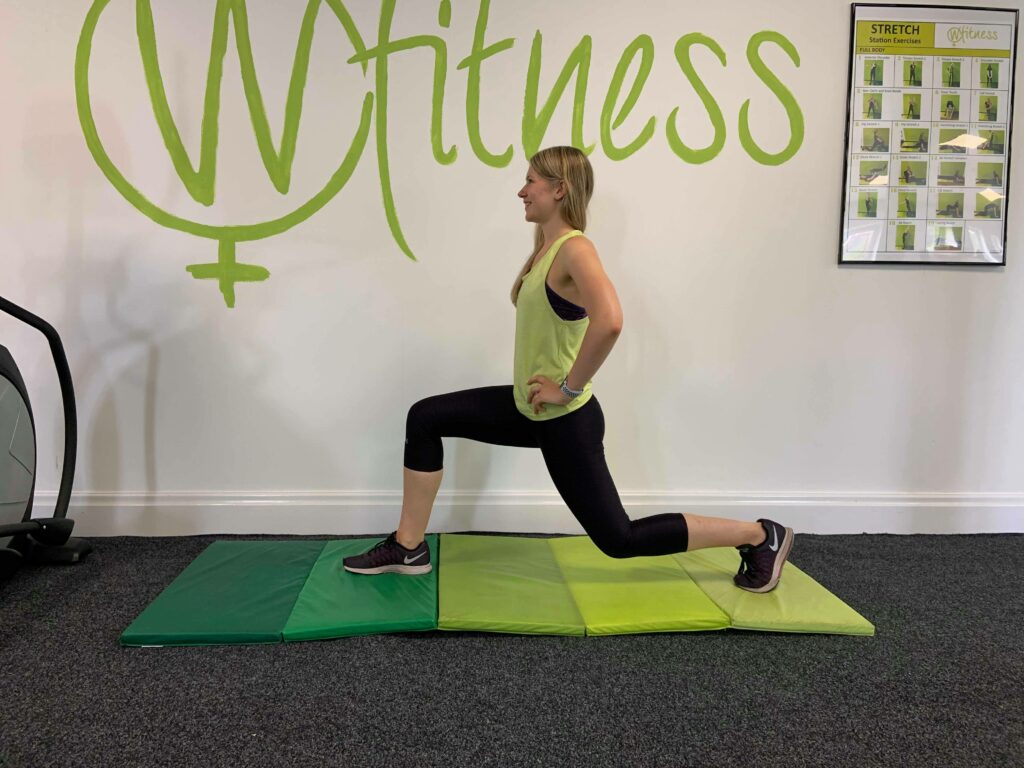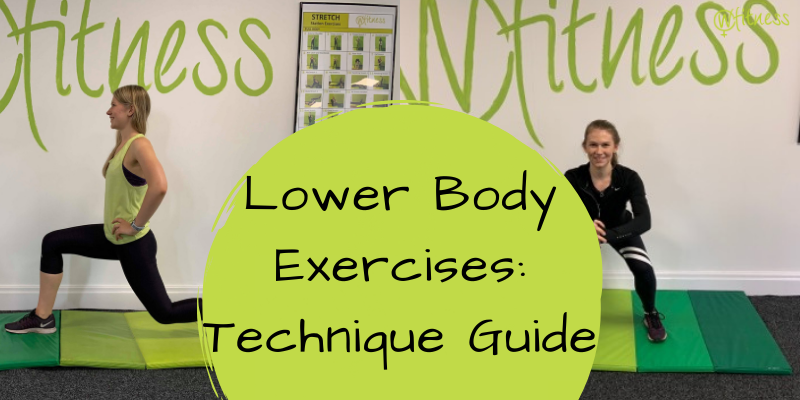Am I Doing These Exercises Correctly!
It’s important to make sure that you are exercising with the correct technique and form, otherwise not only will you not be getting the best out of your workout and working the correct muscles, but you run the risk of injury.
PS are you following us on Facebook? If not, head over there for more daily content from us!
Let’s look at four lower body exercises and how to get the best out of them.
Squats

Squats work the glutes, hamstrings, quads, calves and the erector spinae muscle which runs along the length of the spine. When performed correctly they also help to keep the knee and ankle joints strong as well as helping to keep bones strong by increasing bone density.
Injuries to the knees and spine are a risk if you don’t make sure that you have the correct technique.
How to squat:
- Stand up straight with your feet shoulder width apart.
- Point your toes slightly outwards.
- Keep your head and chest up.
- Squeeze your core muscles.
- Lower yourself down from the hip as though you are going to sit in a chair, until your thighs are parallel with the floor.
- Push back up through your heels until you are back to standing.
Common mistakes are:
- Letting your knees move in front of your toes. This may cause pain or injury in the knees. Make sure that you are pushing your hips back and check your position.
- Pushing back up through your toes. This pushes you forward which puts your weight onto your quads and knees, increasing the risk of knee pain or injury. Keep your weight in the heel and push up through the heel to keep the glutes working.
- Rotating your knees. This puts more pressure on the knees which can lead to back problems. Make sure that you keep your hips over your heels and your knees over your ankles. Adjust the width of your stance to make sure that you are in the right position and can feel your glutes working.
- You bend over too far, putting pressure on the spine. Lean forward slightly but make sure to keep the head and chest up, keeping the head straight (don’t look up to the ceiling) and the chest lifted.
- Don’t rush your squats. Slow and controlled is the way to go. Make sure that you are not rushing to do as many as you can. Watch your position, squeeze your muscles, including your core muscles, breathe and raise and lower slowly.
- Just bending the knees. As well as putting strain on the knees, this will be overworking the quads and not the glutes. Make sure that you start the movement from the hips to engage the right muscles.
Lunges

Lunges work the glutes, hamstrings, quads and calves. Strengthening your quads and hamstrings can help to protect the knees. You will have less risk of knee problems by working these muscles and keeping them strong. Lunges are great for increasing muscle mass to tone and tighten your core, glutes and legs.
Injuries to the knees are a risk if you don’t perform lunges correctly.
How to lunge:
- Stand up straight with feet hip width apart.
- Take a big step straight forward with one leg, making sure that your heel touches the floor first.
- Lower down towards the floor until your thigh is parallel with the floor, and your leg is at 90 degrees. Keep your knee over your ankle.
- A slight forwards move is ok but make sure that your knee doesn’t come in front of your toes. Keep your head and chest up, keeping everything in line.
- Keep your weight even between both legs, making sure that your shoulders are over your hips at the bottom of the move, and your hips are over your back knee. Drive back up, keeping the weight in the heel of the front leg and squeezing the glutes.
- Repeat with the other leg.
Common mistakes are:
- Not taking a big enough step forward. Make sure to allow for your knee to be at 90 degrees.
- Leaning forwards. This can put pressure on your knees. Make sure to keep your torso upright and your shoulders back (don’t hunch forwards).
- Letting your knees come in front of your toes. Again, this can put pressure on the knees leading to an increased risk of injury. Keep your knee over your ankle.
- Not bending both knees. Make sure that you are bending your back knee as well as your front knee.
- Arching your back. Keep your back straight, head and chest up and don’t stick your bum out.
Deadlifts
Deadlifts are a compound movement, working a lot of muscles, but mainly focusing on the glutes, hamstrings and back. Incorrect technique can lead to risk of back injuries.
How to deadlift:
- Using a barbell or dumbbells, stand with your feet hip distance apart and the weight on the floor in front of you.
- Hinge from the hips and, with a slight bend in the knees, keep your back flat and lower down to grasp the barbell or dumbbells.
- When you have grasped the weight, keep your shoulders back, squeeze your glutes and core and return to standing.
- Pause before lowering into your next deadlift, keeping your back flat and your chest up and looking forwards.
Common mistakes are:
- Having your feet in the wrong position. Your toes should be slightly under the bar. Having the bar too far in front of you puts strain on your lower back, which can lead to injury. Make sure that your feet are hip width apart to keep stability in the legs.
- Rounding your back. This can cause compression in the spine when lifting risking damage to the disks. Make sure that you keep your chest up and your back flat.
- Using your back to lift the weight. Make sure that you are pressing through your legs when lifting the weight and not letting your back and shoulders take the strain as this increases the risk of injury. Try to push your feet into the floor to help you use the correct technique and to make sure that it’s your legs that are using the most force and not your back.
- Holding the bar incorrectly. If using a barbell, make sure that you grip the bar a little wider than hip width distance.
- Keeping your legs straight. Don’t lock your knees so that your legs are straight. Start the movement with a soft bend in your knees, and then push back up through the legs.
Glute Bridge

A glute bridge targets the glute muscles, lower back, and hamstrings as well as strengthening hip extension and core muscles. Strong glutes support your lower back and help to prevent knee injuries when lifting heavy items. This is a great exercise for beginners as it is quite gentle. Doing this exercise incorrectly can put strain on your lower back risking injury.
How to do a glute bridge:
- Lie on the floor, on your back with knees bent, your feet under your knees, toes pointing forwards and arms by your side.
- Press your palms and heels into the floor, engage your core muscles and push your hips up until your body is in a straight line (at the top of the movement).
- Squeeze your glutes tightly.
- Pause at the top of the movement before lowering back down and repeating.
Common mistakes are:
- Pushing up through your toes. Pushing up through the toes will work the quads instead of the glutes. Make sure that you push up through your heels to engage the glutes and hamstrings. This is also gentler on the knees.
- Lifting your chest. Remember that it is your hips that you are lifting and not your chest. Keep your chest pressed down and only lift the hips as high as you can by squeezing your glutes. Keep your back flat and concentrate on working the hips and the glutes.
- Over-extending your hips. You must lift your hips off the floor to perform this exercise but over-extending your hips can stretch your back muscles which can lead to lower back pain, and you won’t be targeting the right muscles. Higher is not better when performing glute bridges. You need to make sure that you keep your hips, thighs, and knees in line.
- Not having your feet in the correct position. Make sure that your feet are in a position where you can keep them flat and push up comfortably. If your feet are too close to your body, it will be hard to push up through the heels.
- Arching your back. Make sure to keep your back flat and engage your core muscles to prevent your pelvis from rotating, which will target the quads and not the glutes. Push your back into the floor before you begin the move. This will help you to push your hips up using the legs and not your lower back.
- Doing the move too quickly. If you do this move too quickly, you are more likely to lose the correct technique. Concentrate on the muscles that you are working and keep a controlled movement. Make sure that you are in the correct position and feeling it in the right muscles.
Remember to warm up and activate the muscles before you start exercising. Try to practice mind and muscle connection. If you concentrate on the muscles that you are targeting, you will feel them working.
Why not book your free consultation with us so we can guide you through
Take a look at us to see how we can further help improve your exercise journey!
Much Love
Caroline & Hannah xx
